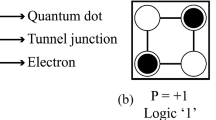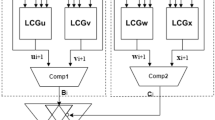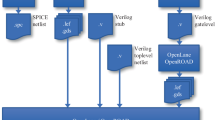Abstract
Noise improves the reliability of logic operations if noise parameter is in certain proper region (reliable region), which is known as logical stochastic resonance (LSR). LSR attracts much attention due to its potential application in new-style logic devices. However, nothing is reported about the effect of cross-correlated sine-Wiener (CCSW) bounded noises on the reliability and agility of logic operations. Here we explicitly demonstrate that in certain proper parameter regions of amplitude and correlation time of CCSW noises, CCSW noises can induce LSR. In addition, cross-correlation intensity of CCSW noises can drastically influence the range of reliable region. By comparison, moderate cross-correlation intensity can drastically destroy the reliability of the logic system, and strongly shrink the optimal parameter ranges, depending on cross-correlation time and amplitude. Moreover, for given amplitudes and cross-correlation time, a little faster logic operation can be obtained with increasing cross-correlation intensity.







Similar content being viewed by others
References
L Lu et al, Nonlinear Dyn. 95(2), 1673 (2019)
M Ge et al, Nonlinear Dyn. 99(3), 2355 (2020)
Y Yao et al, Complexity 2020, 6821591 (2020)
R Benzi, A Sutera and A Vulpiani, J. Phys. 14(11), L453 (1981)
Y Xu et al, Nonlinear Dyn. 95(4), 3237 (2019)
Z He and C Yao, The effect of oxygen concentration on the coupled neurons: Rich spiking patterns and synchronization (Science China Technological Sciences, 2020)
Y Xu et al, Appl. Math. Comput. 385, 125427 (2020)
A Pikovsky and J Kurths, Phys. Rev. Lett. 78(5), 775 (1997)
K Murali et al, Phys. Rev. Lett. 102(10), 104 (2009)
V Kohar and S Sinha, Phys. Lett. A 376(8), 957 (2012)
K P Singh and S Sinha, Phys. Rev. E 83(4), 046219 (2011)
S N R Kazmi et al, Nanoscale 9(10), 3449 (2017)
P Pfeffer et al, Phys. Rev. Appl. 4(1), 014011 (2015)
J Wu et al, Chaos 27(6), 063105 (2017)
N Wang and A Song, IEEE Trans. Neural Networks 27(12), 2736 (2016)
E H Hellen et al, PLOS ONE 8(10), e76032 (2013)
S de Franciscis, G Caravagna and A d’Onofrio, Natural Computing 13(3), 297 (2014)
G Q Cai and C Wu, Prob. Eng. Mech. 19(3), 197 (2004)
D Li et al, Nonlinear Dyn. 70(3), 2237 (2012)
R V Bobryk and A Chrzeszczyk, Physica A 358(2), 263 (2005)
A Donofrio and A Gandolfi, Phys. Rev. E 82(6), 061901 (2010)
Y Yao, M Yi and D Hou, Int. J. Mod. Phys. B 31(28), 1750204 (2017)
Y Yao et al, Physica A 492, 1247 (2018)
Y Yao and J Ma, Cognitive Neurodynamics 12(3), 343 (2018)
Y Yao et al, Complexity 2018, 8793298 (2018)
G Cheng et al, Physica A 520, 361 (2019)
G Cheng et al, Chaos Solitons Fractals 131, 109514 (2020)
L Zhang et al, Phys. Rev. E 96(5), 052203 (2017)
M Aravind, K Murali and S Sinha, Phys. Lett. A 382(24), 1581 (2018)
W Guo, L-C Du and D-C Mei, Physica A 391(4), 1270 (2012)
Y Yao and J Ma, Int. J. Bifurc. Chaos 30(13), 2050196 (2020)
Author information
Authors and Affiliations
Corresponding author
Rights and permissions
About this article
Cite this article
Yao, Y. Cross-correlated sine-Wiener bounded noises-induced logical stochastic resonance. Pramana - J Phys 95, 77 (2021). https://doi.org/10.1007/s12043-021-02120-1
Revised:
Accepted:
Published:
DOI: https://doi.org/10.1007/s12043-021-02120-1
Keywords
- Stochastic resonance
- logical stochastic resonance
- cross-correlated sine-Wiener bounded noises
- bistable system




